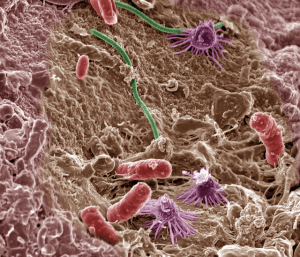The author is ScIU guest writer Emmi Mueller, a graduate student in IU’s Department of Biology.

Image courtesy of Pacific Northwest National Laboratory
What do the deepest parts of the ocean, the human intestine, and outer space have in common? All of these environments are able to harbor a diverse community of microorganisms. Microbes are involved in everything from nitrogen and carbon cycling to amino acids synthesis for other organisms. Because of the important processes they undertake, microbes are integral to ecosystems. However, not all ecosystems are perfectly matched for microbial growth. So how do microbes survive when they encounter harsh conditions?
One method microorganisms use is dormancy — the ability to produce a metabolically inactive state during less-than-optimal growth conditions. Think “hibernation mode” for microbes. An estimated 60% of earth’s microbial biomass exists in some form of dormant state. The Lennon Lab in the Department of Biology at IU is interested in studying how dormancy helps microbes survive harsh conditions through the lens of both ecology and evolution.
When microorganisms enter a dormant state, they use significantly less energy, which allows them to survive when they can’t get enough of it from the environment. If we have a microbe in a nutrient-poor environment, let’s say a soil, it might enter dormancy one of two ways. It may just slow down its metabolic activity and rely on its energy stores, much like a plant seed survives on stores of nutrients before germination, or it may form an endospore. Endospores are dormant and non-reproductive cells that are produced by members of the Firmicutes family that are tougher than other metabolically inactive cells. But now that our microbe is dormant, how will it know when to wake up?
There are two main proposed methods of resuscitation: nutrient sensing and a signaling molecule called Rpf. If our microbe is able to sense that the environment has enough energy and nutrients, it may wake up and ramp up its metabolism! If another microbe nearby wakes up, it may use Rpf, or Resuscitation protein factor, to alert the other microbes nearby that the environment is favorable again. We can see these processes when we bring microbes from suboptimal conditions into the lab: when microorganisms from nutrient-limited deep sea vents are grown in high nutrient environments, they often wake up from their dormant state. This ability to persist through suboptimal conditions allows our microbe to survive where others can’t and, in turn, contribute to the microbial diversity of the soil.
Understanding microbial biodiversity due to dormancy is important to human health and agriculture, too. For example, the bacteria that causes tuberculosis, Mycobacterium tuberculosis, is able to linger in a dormant state for years to decades after an initial infection. Agricultural plants rely on a diverse group of soil microorganisms to increase resource uptake as well as provide novel nutrient sources. If farmers are able to wake up beneficial soil microorganisms that are typically dormant in their fields, they may be able to increase crop yield and improve plant health. By studying dormancy and microbial biodiversity, the knowledge can be applied to solving food scarcity and combat diseases as well as understanding the diversity of species in natural environments.
Reference:
Lennon, J. T. & Jones, S. E. (2011) Microbial seed banks: the ecological and evolutionary implications of dormancy. Nat Rev Microbiol 9, 119–130. Link to full-text article.
Edited by Kimberly McCoy and Rachel Skipper

Leave a Reply